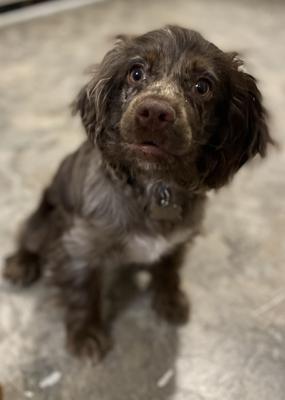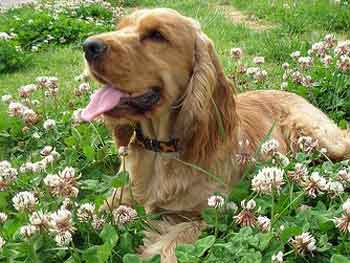- Home
- Puppy Obedience Training
Teach your puppy obedience training will help keep him safe!
Giving your puppy obedience training doesn't necessarily mean he's a naughty puppy and needs training (although it will work wonders if he is!).
Obedience training is simply a way of teaching your new little boy how to behave well, and as a bonus, it can keep him safe too!
So, if you'd like a well-mannered Cocker Spaniel (and who wouldn't?), read on to learn how best to achieve it.
Basic Obedience Training for Puppies
Dog obedience training is one of the first stages in puppy training, and it's your first few steps towards a well-behaved Cocker Spaniel puppy.
I aim to give you the tools (and the confidence) to teach your Cocker puppy to listen to your every word and respond to your requests willingly and quickly.
After reading this article, you should be able to teach your puppy basic obedience commands, such as sit, down, come, stay, and a few more besides.
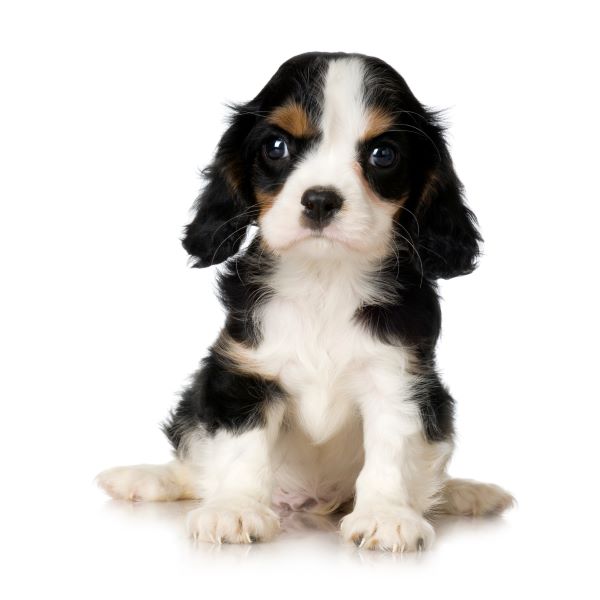 Good puppy obedience training will give your puppy great manners!
Good puppy obedience training will give your puppy great manners!Puppy obedience training is easy once you know how, but it can sometimes be frustrating if your pup doesn't 'get it' immediately.
I recommend you read these training tips before you go any further to help you get the best out of the following obedience training.
Keep your sessions short, frequent and, most of all, make them fun.
Good luck, and enjoy yourselves!
At What Age Should I Begin Puppy Obedience Training?
Puppies learn quickly and in various ways. They learn from their mother, siblings, their human family and their environment. However, you shouldn't simply leave it to chance.
You should begin training your puppy as soon as you get him home from the breeders, usually around eight weeks of age.
Puppy obedience training can remarkably affect your puppy's temperament and behaviour, helping shape a well-behaved Cocker Spaniel.
Puppy Obedience Training: 'Watch Me!'
You will find the 'Watch Me!' command very useful.
'Watch Me!' will teach your puppy to look at you and to pay attention, ignoring everything else (and hopefully, everyone else) around him.
Use this command and get your puppy's full attention.
Once learned, it can help make all other puppy training much easier for you both.
Use it before beginning his training exercises, and it will help you to teach him more quickly because he's much more likely to respond to your commands when he's paying attention and listening to you!
If you'd like to teach your puppy to 'Watch Me!' and get his full attention whenever you need it, follow the link.
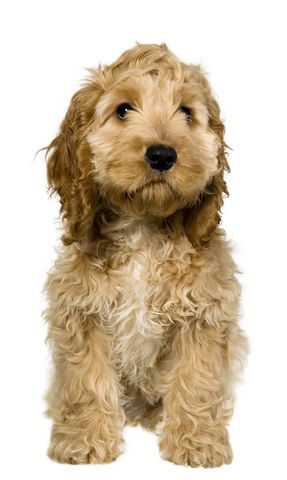 What an obedient little puppy!
What an obedient little puppy!Puppy Dog Obedience Training: 'Here Boy!'
Out of all the puppy obedience training commands, the recall command is one of the most important things you'll ever teach your little guy because you may need to get him out of danger at some point.
If you train your dog to come, this recall command could save his life!
Getting your puppy to return to you can sometimes be tricky, especially outdoors, because there are so many distractions, but with patience and persistence, he'll soon get the hang of it.
Once he's grasped the basics of this lesson, you'll need to make sure you repeat this command in many different places and situations.
For example, it's relatively easy to get your puppy to come to you when you're indoors and you have a tasty treat in your hand, especially if he can see or smell it.
Calling him to you when he's playing with his favourite toy, and you've nothing better to offer him, well, that's an entirely different matter!
At first, your puppy may take a little while to come to you, and he'll probably have a few stops along the way, but so long as he's making his way back to you, that's fine.
Your ultimate goal is to get him to come to you when you call him.
Repeat and practice this command daily so that no matter what he's up to, your puppy returns to you the minute he hears the words, 'Here boy!'
Puppy Obedience Training: How To Train Your Dog To 'Sit!'
This is probably one of the easiest lessons to teach your puppy, and it's such a useful exercise because you'll use it in so many different situations.
'Sit!' is one of the most straightforward lessons to teach your puppy, and it's such a useful exercise because you'll use it in so many different situations.
For example, I always ask Max to sit while I put on his collar and lead before taking him for a walk.
And he understands that before he's allowed to eat his dinner, your puppy must sit quietly by his bowl and wait until I let him know he can eat; otherwise, no dinner. (I'd never not feed him, but you know what I'm saying!)
Now I no longer need to give the command; when it's time to put on his collar or feed him, he sits automatically.
I also ask him to sit down before I open the front door to visitors, and again I no longer need to give the command; he just does it.
These are a few good disciplines to adopt for your pet (there are more), and apart from putting your Cocker Spaniel into a calm, relaxed state, the 'Sit' command will help to reinforce your place as his pack leader.
Puppy Obedience Training:'Down!'
The last thing any dog owner wants is an over-excited puppy jumping up at anyone who visits their home!
And the same applies to when you meet people in the street!
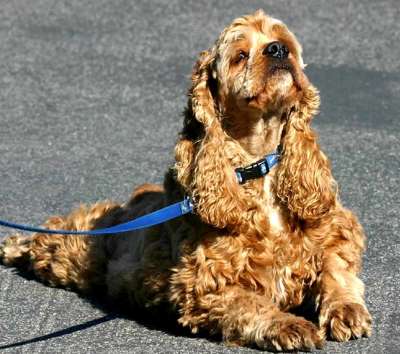 The 'Down' command will calm your dog.
The 'Down' command will calm your dog.Situations like these are where the 'Down' command can help to keep your puppy calm and quiet, and it's especially useful to use if there are young, excited children around.
Putting your dog into this position helps to stop him from becoming over-excited, and its calming effect could also help prevent him from knocking over a young child!
When your dog is in the down position, he's relaxed, calm and submissive.
Puppy Obedience Training: 'Stand!'
There will be many occasions when you ask your puppy to stand up for you. For example, you will want your Cocker to stand while you groom him, bathe him, or while his vet checks him over.
There will be many other situations where you will require your puppy to stand, especially if you intend to take him to dog obedience and socialization classes or if you plan to show him when he's older. It's well worth teaching your puppy to stand as soon as possible.
Puppy Obedience Training: 'Be Quiet!'
At first, you might think it's cute when your puppy barks at someone, but it can quickly become a nuisance if it continues or becomes a habit, no matter how sweet your little boy is!
If you ignore a barking puppy (or worse, you encourage your puppy to bark), you may find it difficult to stop him when he's older because he may begin and continue barking simply out of habit.
Besides this, continuous barking is not good manners!
One of the easiest ways to stop your puppy barking is to teach him the "Be Quiet" command.
Teaching your puppy to bark may sound contradictory, but the idea is to train him to bark and then teach him to stop barking; a quiet Cocker Spaniel is guaranteed!
I don't recommend you encourage your puppy to bark unless you're going to teach him this command.
Puppy Training: 'Wait!' and 'Stay!'
Wait and Stay are two commands that you can use in different situations.
If you decide to use both, you must understand the difference between the two before you teach your puppy either of these commands.
I explain the differences here and how to teach your puppy both 'Wait' and 'Stay' commands.
If you prefer to teach your Cocker Spaniel only one of these commands, you could simply use either one for all situations; it's your choice.
Puppy Obedience Training: 'Down and Stay!'
You've just come through the door, laden with shopping, your puppy is jumping around your feet, and you almost trip over him.
Does this sound familiar?
You will often need your puppy to lie down and stay where he is until you can make a fuss of him or see to his needs.
Without sounding too obvious, this command is simply a combination of two training commands.
The 'Down and Stay' instruction is handy when your dog is unnecessarily boisterous or a little pushy and demands too much attention!
It goes without saying that your pup must have mastered both the 'Down' and 'Stay' commands separately before you try and teach him this one.
Puppy Obedience Training: 'Leave It'
As is their nature, puppies are into everything, and your Cocker Spaniel puppy may likely pick up something unpleasant, something you really don't want him to eat.
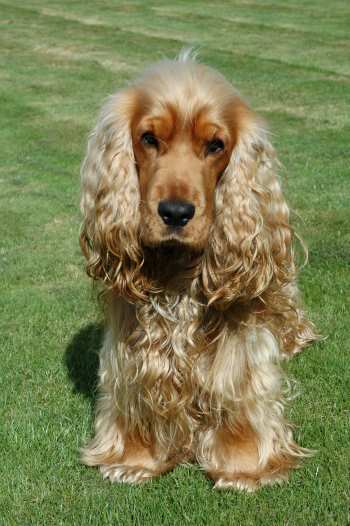 My Cocker Spaniel Max waiting for his next instruction!
My Cocker Spaniel Max waiting for his next instruction!You shouldn't be surprised at how much you'll use this command with a curious puppy in the house.
Here is an example of when you might want to use this command.
You're on a walk with your Cocker Spaniel when he sniffs out a dead and decomposing rabbit or something equally unpleasant, something you wouldn't want him to touch, let alone eat or roll in, which he'll almost certainly try to do!
If you successfully taught him the 'Leave It!' command when he was a puppy, you can be confident that he won't go near it; he will respond to you by ignoring that lovely stinky decomposing bundle and continue his walk with his master.
Obedience Training: 'Drop It!'
If you find it's too late to use the Leave it! command (i.e. your puppy already has it in his mouth!), then this is the command to use.
And if your puppy ever manages to get his paws on a bar of chocolate, you need to be able to get him to drop it immediately. (Easter time is a particular problem with all those yummy chocolate eggs lying around!). Dark chocolate is incredibly toxic to puppies and wouldn't take much to make them quite ill.
It's an excellent idea to teach your puppy the "Drop It!" command as early as possible and help keep him safe from harm!
Dog Obedience Training: What's Next?
I hope you've enjoyed teaching your new pet these obedience commands and that you're well on your way to having a happy, well-mannered little Cocker Spaniel puppy!
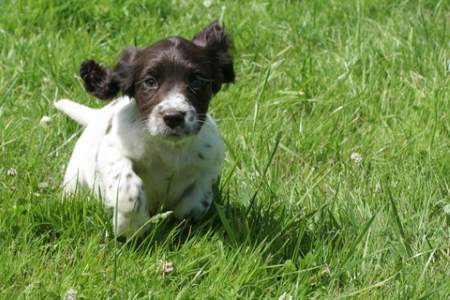 Letting off steam after obedience classes!
Letting off steam after obedience classes!But training puppies doesn't, and shouldn't stop here.
Your Cocker Spaniel will mature and eventually become an older dog, but that doesn't mean his training should become a thing of the past.
I'm sure you've heard the saying, 'Use it or lose it'; well, the same applies here, too, and all obedience training should be continued and reinforced throughout your pet's life to help make sure his manners don't slip!
To help lighten up a little, you might like to take a break from your puppy's obedience training and teach him some cool games; follow the link for details.
Photo credits: Puppy Obedience Training
1. GlobalP at https://www.istockphoto.com/photo/cavalier-king-charles-spaniel-puppy-gm93210533-3598809
2. Esviesa at Dreamstime.com - https://www.dreamstime.com/stock-photography-cocker-spaniel-big-ears-image23155812
3. Mike Baird at Flickr.com - https://www.flickr.com/photos/72825507@N00/323625789
4. Copyright about-cocker-spaniels.com
5. Jordan Johnson at Dreamstime.com - https://www.dreamstime.com/royalty-free-stock-images-i-m-coming-image5746749





